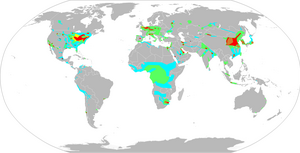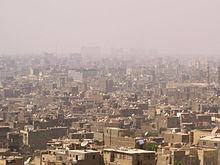good day.follow this blog.
The World Health Organization defines air pollution as the alteration of the natural characteristics of the atmosphere caused by biological and chemical contaminants. Air pollution is known to pose a major health risk, as it can lead to the development of respiratory conditions, heart problems, and even cancer.
Unknown to many people, their daily routine activities at home and at work contribute to the worsening of air pollution. If you want to help the environment recover from air pollution, then here is a list of the ten biggest causes of air pollution. Take a look at this list and see if there is anything you can do to help the environment.
1. Exhaust from Combustion Engines
(Photo courtesy: Wikipedia)
While modes of transportation such as cars, ships and planes have made people’s lives easier, they are also some of the biggest causes of air pollution. Emissions from vehicular combustion engines contain gaseous oxide, nitrous oxide and carbon monoxide, all of which contribute to the depletion of the ozone layer. With a thinner ozone layer, the earth will gradually succumb to sweltering heat.
The melting of the polar ice caps and the rise of sea levels are just some of the jeopardizing effects of air pollution-induced global warming. Apart from environmental damage, air pollution also causes a variety of illnesses such as impaired vision, reduced brain function, lung cancer, and in some cases, death.
2. Use of Coal and Fossil Fuels
(Photo courtesy: Wikipedia)
Factories, power-generating establishments, offices, even homes, utilize fossil fuels and coals for power or heat. Even though beneficial, coal and fossil fuels contribute to air pollution and smog. They also damage structures and hasten the oxidation of iron. Add to that, they can cause harm on plants, which significantly reduces oxygen supply on earth.
3. Petroleum
(Photo courtesy: Wikipedia)
Petroleum is the driving force behind vehicles, however, this helpfulsubstance is a major contributor to global air pollution. Petroleum releases carbon dioxide and nitrous oxide into the air, which, when inhaled, can lead to illnesses.
It also contains hydrocarbons, which bind to nitrous oxide in the presence of sunlight to create ozone. While the ozone layer technically protects the earth from the ultraviolet rays of the sun, it also gives way to the production of smog, which is the leading cause of a variety of lung problems.
4. Mining Operations
(Photo courtesy: Wikipedia)
Operations, like mining and truck traffic, are some of the top causes of air pollution. These activities release carbon monoxide, sulfur dioxide and nitrous oxide into the air, all of which contribute to development of smog and various health problems. Apart from these emissions, gold mines also release mercury particulates to the atmosphere. In excess amounts, mercury inhalation can lead to sensation disturbances, muscle weakness, respiratory problems, certain cancers, even death.
5. Stationary Sources: Plants and Mills
(Photo credit: Explorer Björn | Flickr)
On the process of generating their products, paper mills, steel mills, iron mills, cement plants and asphalt plants release aerosols, particulates, gases and vapors into the air. These mills and plants, also known asstationary sources, yield ammonia, sulfur oxide, hydrogen chloride and hydrogen sulfide, to name a few.
Fortunately, these air pollution causes have managed to reduce their emissions with the use of control devices like carbon adsorbers, fabric fillers, cyclones and electrostatic precipitators, to name a few.
6. Fertilizer Dust
(Photo credit: Henry Work | Flickr)
Fertilizers are useful for farmers as they accelerate the growth of crops and plants. Nonetheless, the accumulation of fertilizer dust (even those made from organic ingredients) can give way to the production of ammonia and nitrogen oxide, both of which contribute to global warming and harmful acid rain. Such pollution also yields methane, a greenhouse gas. With the presence of high amounts of methane in the atmosphere, the heat that should have been radiated back to the atmosphere are bounced back to earth, keeping the earth insulated.
7. Chemical Pesticides
(Photo courtesy: Wikipedia)
Pesticides are very helpful for farmers as they keep vermin, bacteria, and fungi that destroy their crops at bay. However, use of pesticides, especially those made from chemicals, also wreaks air pollution. Air pollution caused by pesticides can be fatal for animal, birds, even marine life, especially if the emissions already infiltrate their food sources.
Apart from its contributory effects on air pollution, pesticides actually damage plant health in the long run. Incessant use of chemical pesticidesleads to decreased plant production and pollination, which then results in lower crop yields.
8. Power Lines
(Photo credit: FullyFunctnlPhil | Flickr)
Just because power lines don’t emit visible smoke, it does not mean that they are not among the causes of air pollution. In fact, high voltage lines, especially those located near polluted cities, attract air that contains harmful particulates. The electricity running through the lines results in the charging or the ionization of the air.
When inhaled by humans, ionized air significantly increases the level free radicals in the body. These free radicals in the body bring about tissue damage, aging, even the development of certain cancers.
9. Radioactive Fallout
((Photo credit: dreamlandresort.com)
Radioactive sources yield high amounts of energy, as well as harmful quantities of sulfur dioxide and several heavy metals into the air. In highly-industrialized cities, air pollution from radioactive fallout have been proven to create numerous environmental concerns, such as defoliation, deformation and undergrowth damage in trees, to name a few.
Apart from its impact on the environment, radioactive air pollution also endangers human health. Perhaps the most infamous case of radioactive fallout is that of Chernobyl in Ukraine, wherein the survivors of the nuclear meltdown developed cancers and a variety of respiratory ailments after inhaling emissions coming from the nuclear plant.
10. Indoor Air Pollution
(Photo credit: nirvana168 | Flickr)
Outdoor air pollution causes contribute to a number of contaminants in the atmosphere. It should be noted though that indoor air pollution also plays a major role in the worsening air quality around the world.
Urban infrastructures are usually afflicted with a condition called “Sick Building Syndrome.” In this case, fumes from household chemicals, paint, and other substances get trapped in the building because of the lack of ventilation. These fumes can cause a variety of health problems for its homeowners, tenants, or visitors.
While technological advancements have paved the way for innovations in transportation, agriculture, and energy production, the fact of the matter is they have become the biggest causes of air pollution. Hopefully, knowing about these top ten causes can motivate you to make a move to contribute for a cleaner, safer air.



